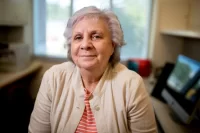
Here’s the seventh and final installment of our series that profiles, in images and words, each and every resident of Bates’ newest academic building, Bonney Science Center, as they begin to engage with their wondrous new home and the students they work with. This week’s profiles feature:
- Lori Banks, an assistant professor of biology who encourages her students’ to lead with their hearts and hands.
- Andrew Kennedy, an assistant professor of chemistry and biochemistry whose students have a certain glow.
- Jennifer Koviach-Côté, an associate professor of chemistry and biochemistry who carries the many languages of chemistry with her.
- Jason Castro, an associate professor of neuroscience who has a nose for his research.
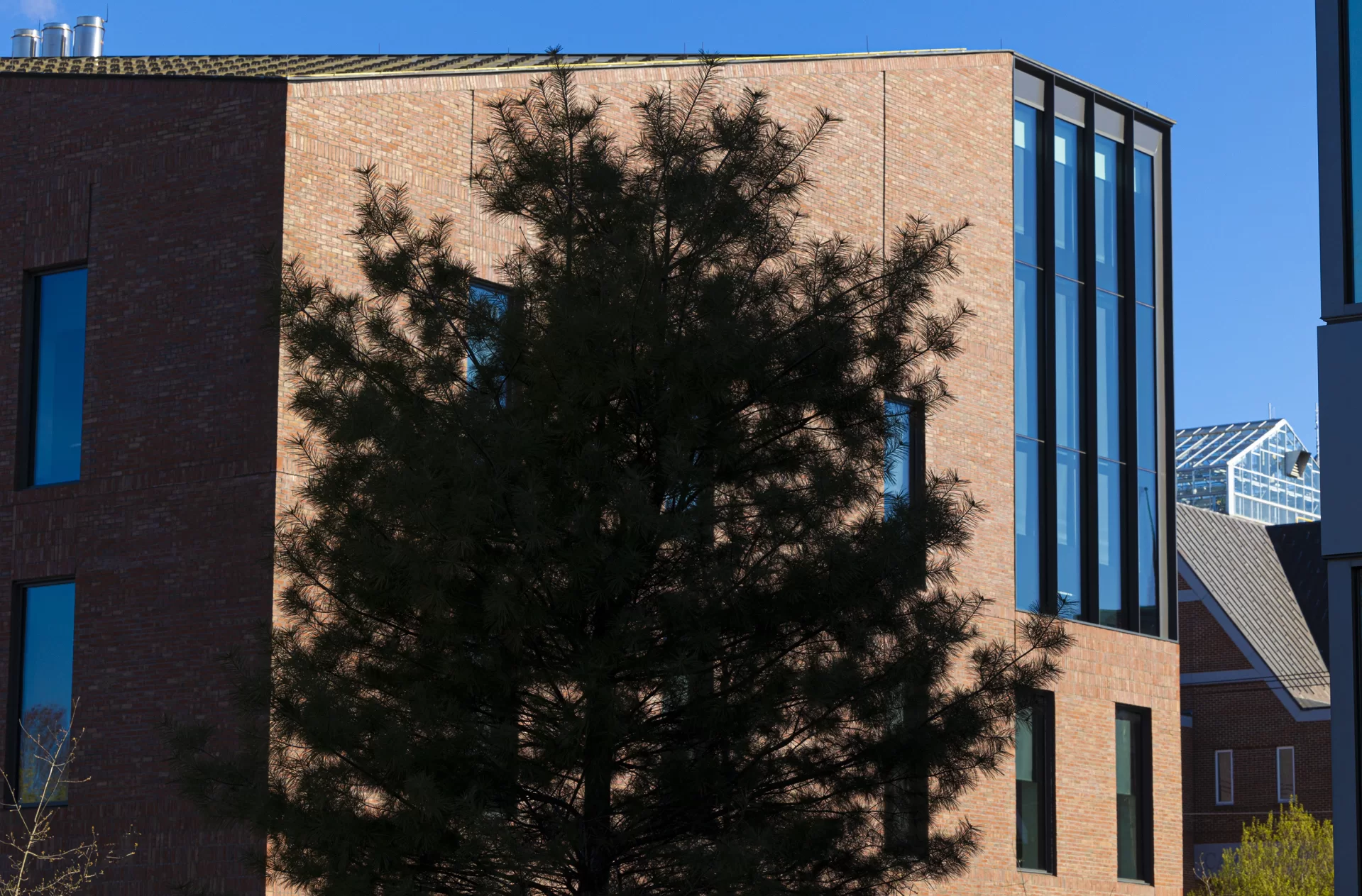
Lori Banks
Title: Assistant Professor of Biology
Joined Bates: 2019
Date Photographed: Nov. 30 and Dec. 3
She says: “When you put the right opportunity in front of a student, you see their personality change.”
Assistant Professor of Biology Lori Banks teaches in a Bonney Science Center classroom and conducts research in a Bonney lab. But the science she pursues is everywhere, “whether it’s mathematical modeling or physics in a pressure cooker in somebody’s kitchen.”
In her lab, Lori Banks and her student researchers explore preclinical drug development, “mostly in the area of antimicrobials for both bacteria and viruses,” she says. “I’m sort of a hybrid microbiologist / biochemist.”
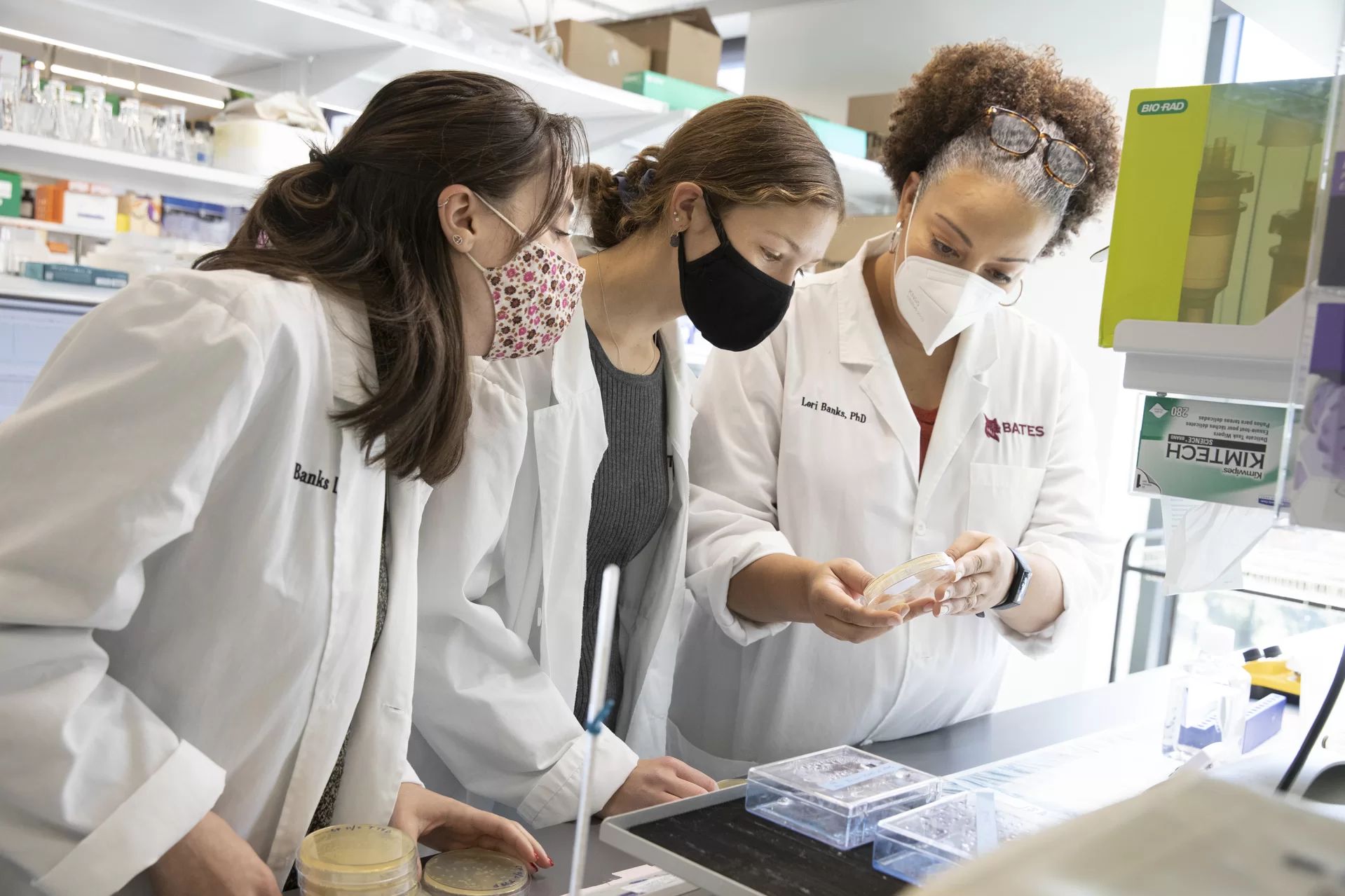
Among her current projects is one looking at the workings of a specific non-structural protein in rotavirus. (Viruses use non-structural protein to replicate themselves, among other purposes.)
In the classroom, Banks teaches courses that explore the cellular basis of life as well as cellular biochemistry and microbiology. Next fall, she’ll teach one of the department’s new CURE courses, delivering a Course-Based Research Experience, looking at microbes.
As a teacher, Banks says she “definitely draws a lot from Ms. Frizzle,” referencing the fictional elementary school teacher of The Magic School Bus edutainment fame. (Fun fact: The theme song for the TV series was sung by Little Richard.)
“She’s just sort of this free spirit science teacher whose magic bus can take her class out to space or shrink them and let them watch molecules interact inside of a baking cake.”
Silly stuff, but serious intent. “To encourage people to do stuff, get your hands in it. Let them get messy. That’s how you’re really going to learn things and retain the information.”
To that end, Banks’ cellular biochemistry last fall had a heaping helping of community engagement, as the students helped a Lewiston Middle School class learn about the value of a healthy, vitamin-rich diet. The course culminated in a recipe contest, the youngsters choosing an omelet dish as their favorite.
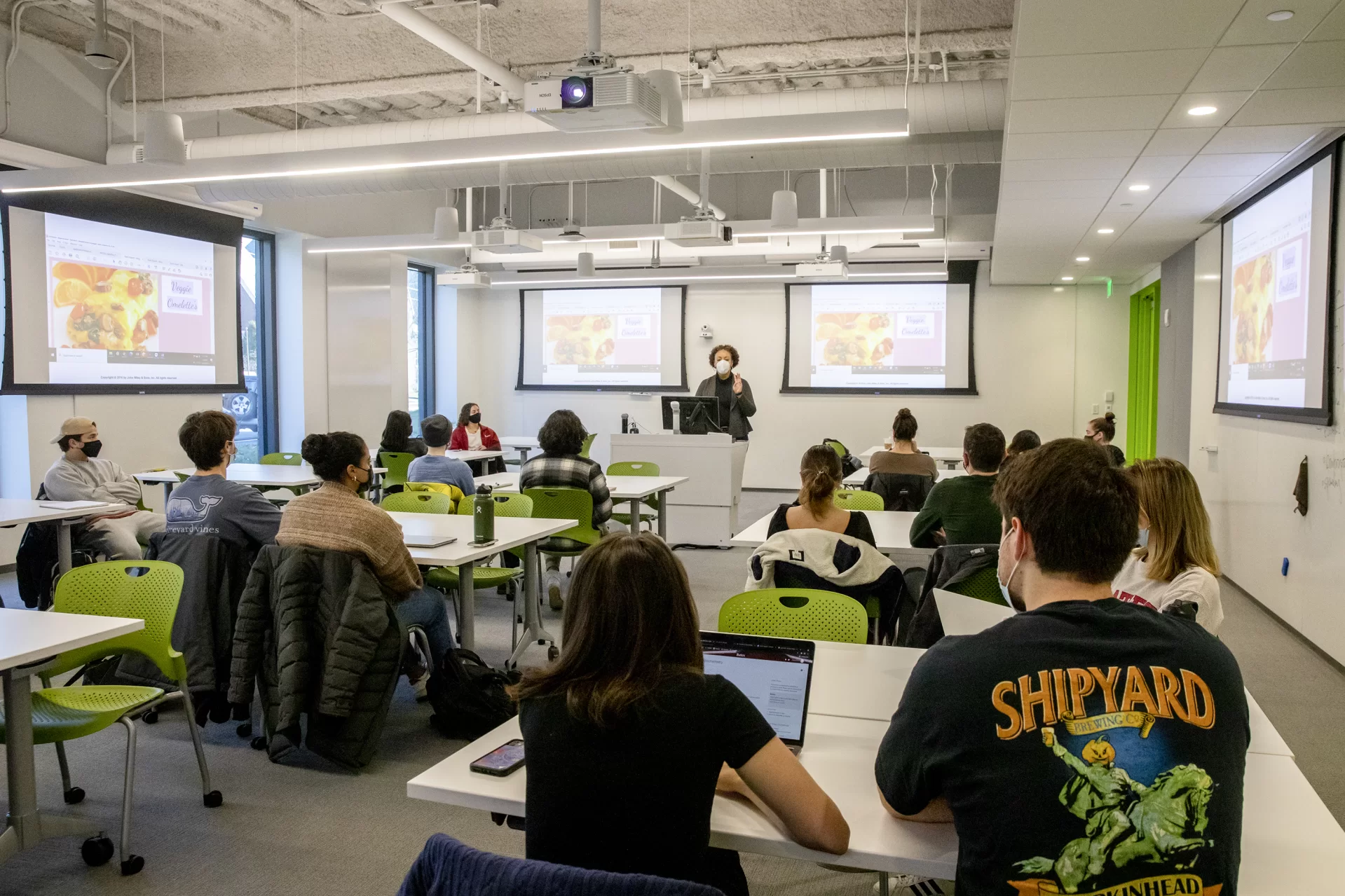
Banks also works with the STEM Scholars program, which helps students from underrepresented groups who are interested in pursuing science or math begin to think like, and believe in themselves as young scientists.
The best part about teaching, Banks says, is providing what she calls a “landing pad, a safe environment for them to screw up some stuff and figure it out.”
The Banks landing pad means that a student, after failing, can back up and try again or try something new. “You see a student trudge through a few things for a couple of weeks, and they’ll say, ‘That’s really not my jam. I don’t ever want to do this again.”
Banks will talk with the discouraged student, giving them a chance to reflect on what happened. From that, Banks might suggest a different area of science.
“And when you put the right opportunity in front of them, you just see their whole personality change. They’re like, ‘I didn’t know they made this part of science before, but I’m glad they did. I want to go play!’”
Andrew Kennedy
Title: Assistant Professor of Chemistry and Biochemistry
Joined Bates: 2016
Date Photographed: Nov. 17, 2021
He says: “Bates students can walk right over to their own high-field NMR instrument and analyze their own data.”
The newspaper story was incredulous: “Put one drop of blood in a barrel of water and toxicologist, Joseph B. Swim, San Francisco toxicologist, can detect it. He uses 3- aminophthalhydrazide. He can even pronounce it!”
That was in 1937, when crime investigators first began using the chemical compound, commonly known as luminol (not to be confused with the barbiturate Luminal) to detect blood at crime scenes. Luminol is chemiluminescent, meaning it glows when it chemically reacts to something, in this case the iron in hemoglobin.
As the 1937 story noted, and Assistant Professor of Chemistry and Biochemistry Andrew Kennedy confirms today, “even small amounts of iron will emit light, making the presence of blood easy to detect.”
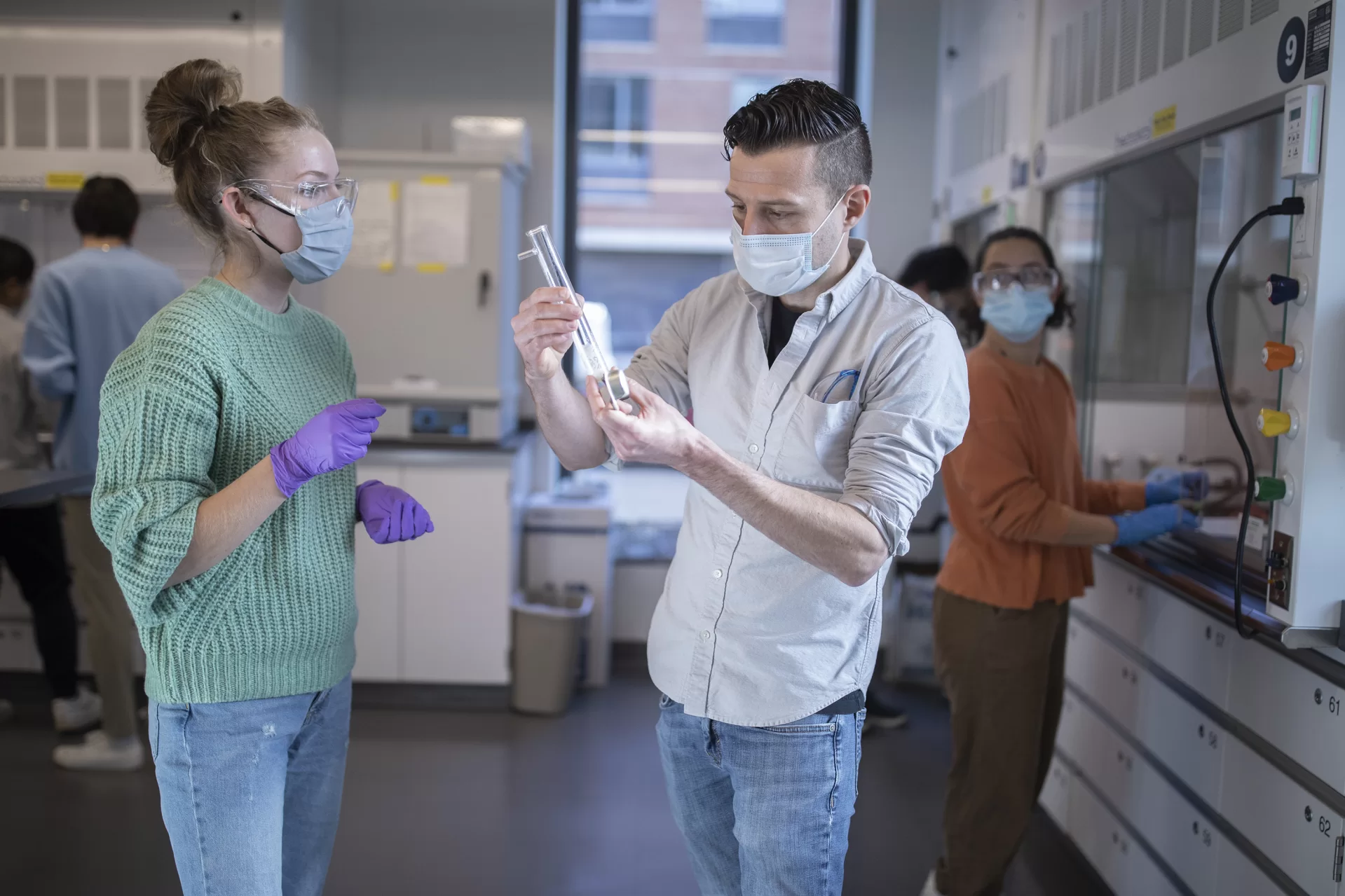
On a Wednesday afternoon last November, Kennedy was teaching his organic chemistry students how to synthesize their own batches of luminol, a multistep process involving a few chemicals plus heat.
As he moved about the lab, he stopped to guide Oli Seline ’24 of Delaware, Ohio, with her experimental setup, specifically how to correctly position her reaction tube, like a test tube, over a Bunsen burner.
Later, in a darkened area just off the first-floor teaching laboratory of the Bonney Science Center, Jake Johnson ’24 of Lake Forest Park, Wash., tested whether the luminol he had synthesized in the teaching lab would successfully detect iron.
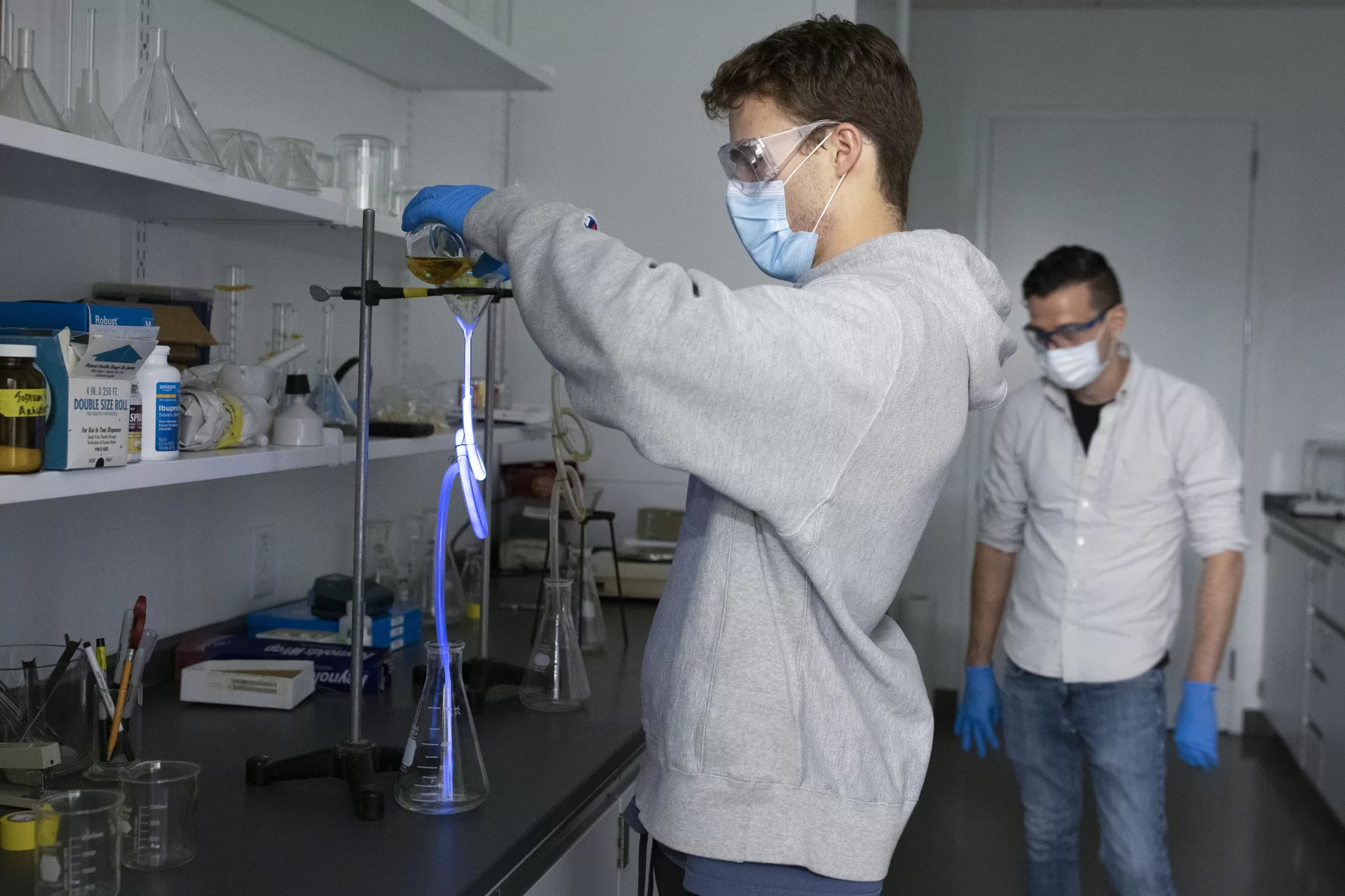
And it did. As he poured mixtures from two beakers, one containing luminol and the other an iron complex, into a funnel, the mixture began glowing as it flowed into a larger beaker. Seeing was believing for Johson. “It was fascinating to see an actual reaction,” said Johnson.
The sophomores that Kennedy worked with last November may someday be the juniors and seniors who join Kennedy’s lab, which seeks to better understand the chemical mechanisms that encode and maintain long-term memory. The lab also works to create new molecules, such as Bobcat339, that possess epigenetic properties,, that govern the function of genes, including those related to memory loss.
When Kennedy taught undergraduate organic chemistry at his Ph.D. institution, “students didn’t even get to analyze samples,” he says, partly due to numbers and partly because undergraduates didn’t rate. “There were too many of them, and the important equipment for organic analysis, like nuclear magnetic resonance instruments, were exclusively used for the graduate-level research projects.”
Now, he says, “Bates students can walk right over to their own high-field NMR instrument, load their own reaction sample, and analyze their own data.”
(Fun fact: The NMR in Bonney was made possible by Dennis Keith ’65 and Jo-Linda Leib Keith. Dennis was a chemistry major who earned a Ph.D. from Yale and had a long and successful pharmaceutical career. “Dennis took organic chemistry when Hedge Hall was the chemistry building,” says Kennedy. “He remembers Dana Chemistry Hall as a hole in the ground. It’s pretty incredible that he would be connected to the Bonney Science Center in this way.”)
Jennifer Koviach-Côté
Title: Associate Professor of Chemistry and Biochemistry
Joined Bates: 2001
Date Photographed: Nov. 16, 2021
She says: “Having the decal provides continuity between students who have worked in my lab in the past with students of the future.”
In Dana Chemistry Hall, now in the finishing stages of a year-long renovation to become a science teaching space, the old fume hoods have been replaced with new ductless hoods that use replaceable charcoal filters.
The new hoods filter the fumage instead of piping fumes out of the building. The innovation will reduce HVAC costs because air won’t have to be cooled or heated as it’s brought into the building to replace the exhausted air.
But a bit of Bates chemistry history has been lost. Well, almost lost.
Around 15 years ago, a tradition was born when students of Associate Professor of Chemistry and Biochemistry Jennifer Koviach-Côté’s students began to use Sharpies to write the word “chemistry”on the lab’s fume hood in the language of their home or heritage.
The Japanese word for chemistry kicked it off:
Over time, other students from other countries followed: Nepali, Russian, Korean, Spanish, French, Swahili, Hindi, Singhalese, Hebrew, Norwegian, Lithuanian, Irish Gaelic, English, German, Japanese, Chinese (traditional and simplified), Vietnamese, and Burmese.

That word-strewn hood is gone, but not forgotten. Last year, Koviach-Côté’s thesis students gave her a lab-warming gift: a decal created from a photo of all the “chemistry” translations from the old sash.
“Having the decal provides continuity between students who have worked in my lab in the past with students of the future,” she says.
Koviach-Côté teaches one of the mainstays of the departments’ offerings, organic chemistry. She also teaches an upper-level course that teaches students how to use two powerful tools, nuclear magnetic resonance and mass spectrometry, to glimpse and analyze the inner workings of molecules.

Koviach-Côté’s lab, meanwhile, synthesizes (creates, that is) and investigates organic molecules and carbohydrate-containing compounds. “We study compounds with antioxidant activity and others with antiviral activity,” she explains. “One compound is active against respiratory syncytial virus (RSV) which mostly affects infants.”
On a Tuesday morning in November, four of her five thesis students were at work in the lab, including Sean Agrodnia ’22 of Cape Elizabeth, Maine.
For his senior thesis, done in collaboration with Assistant Professor of Chemistry and Biochemistry Colleen O’Loughlin — “who now works down the hall from me,” says Koviach-Côté — Agrodnia investigated the antibacterial properties of phenylpropanoid glycosides, which are natural compounds found in various medicinal plants. (Fun fact: PPGs can be found in gingko trees, several of which were planted just outside Bonney.)
When asked what’s better about her new lab, Koviach-Côté says, “Space. More elbow room to have multiple experiments at the same time and accommodate more students to work in the lab at the same time.”
And better HVAC, which benefits humans and chemistry alike. “It means that experiments are performed at consistent temperatures regardless of the season.”
Jason Castro
Title: Associate Professor of Neuroscience
Joined Bates: 2012
Date Photographed: April 1, 2022
He says: “Now I’m spoiled.”
Payette, the architectural firm that designed Bonney Science Center, had a specific purpose in mind for most spaces: teaching, research, office work, or storage.
But there are some purposefully purposeless spaces, like Room 283, where Bates folks can meet, discuss, laugh, and figure things out.
On April 1, the room was the scene for a lively meeting between Associate Professor of Neuroscience Jason Castro and two of his thesis students, Johnny Loftus ’22 of Palo Alto, Calif., and Juliet Bockhorst ’22 of Westwood, Mass.
There were some light moments as the trio used the whiteboard to sketch out some charts reflecting the work the students were doing in “principal component analysis,” an important technique in statistics and data science.
After a difficult, month-long project, the two “had identified what might be two new cellular subtypes,” explains Castro, “using machine-learning techniques to determine whether these cells could be classified into different types.”
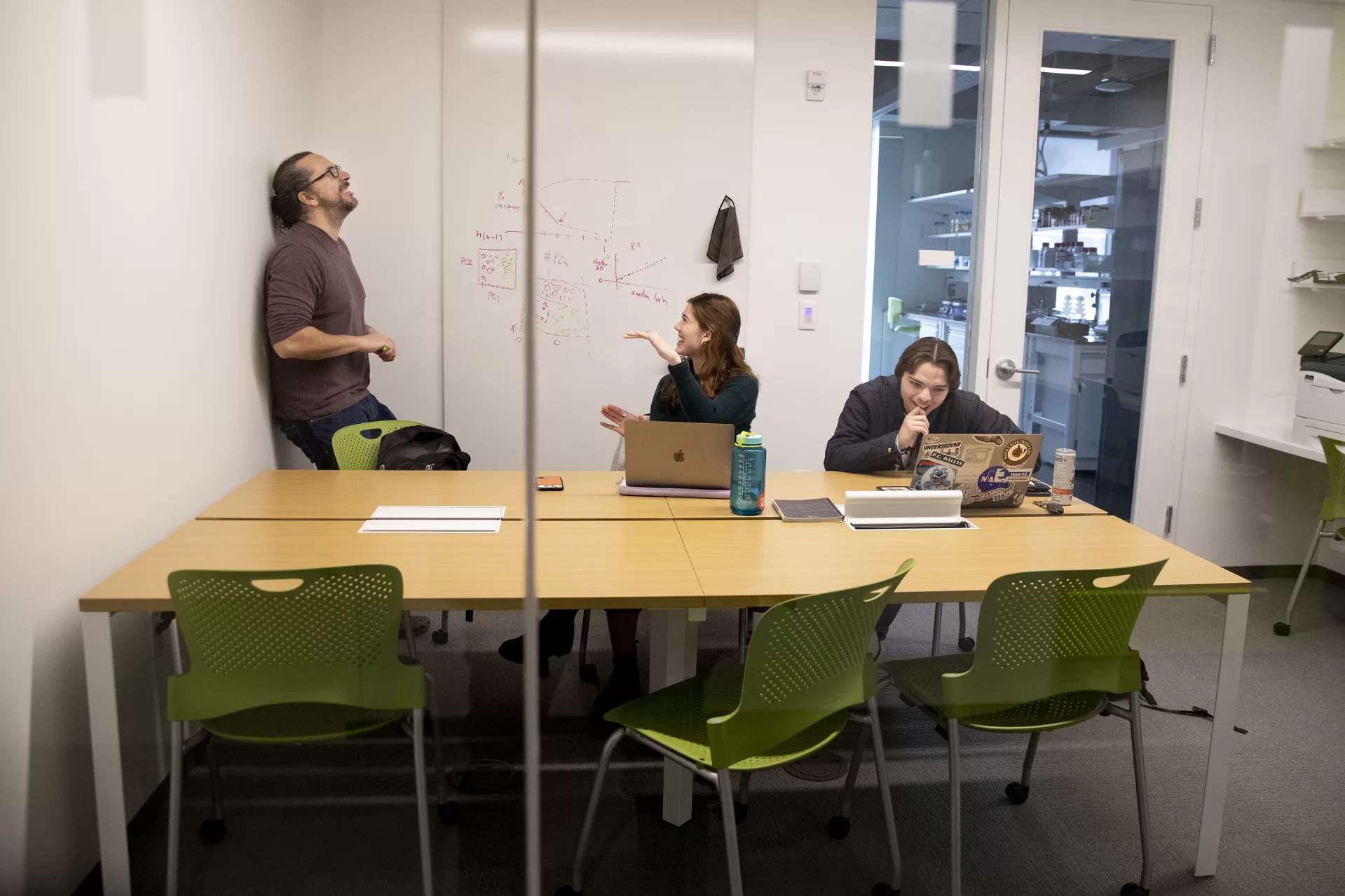
He doesn’t recall the reason for the levity. “Juliet may have been talking about some of the challenges she faced when trying to label neurons” — which was key to the project — “and was making light of it.”
Castro’s lab researches how we smell. (Not if we’re smelly, but how our olfactory system works.)
Take the various and tantalizing smells that hit Bates students as they walk toward Commons for a meal. Whether it’s the allure of barbecue tempe, bacon and ham pizza, paprika braised mushrooms, or tiramisu coffee cake, it’s simply chemicals hitting and stimulating the collective Bates nose.
“Although we know we can smell a huge number of volatile chemicals, we still don’t understand exactly how this information is handled by the olfactory bulb – the part of the brain that receives incoming signals about smells,” Castro says.
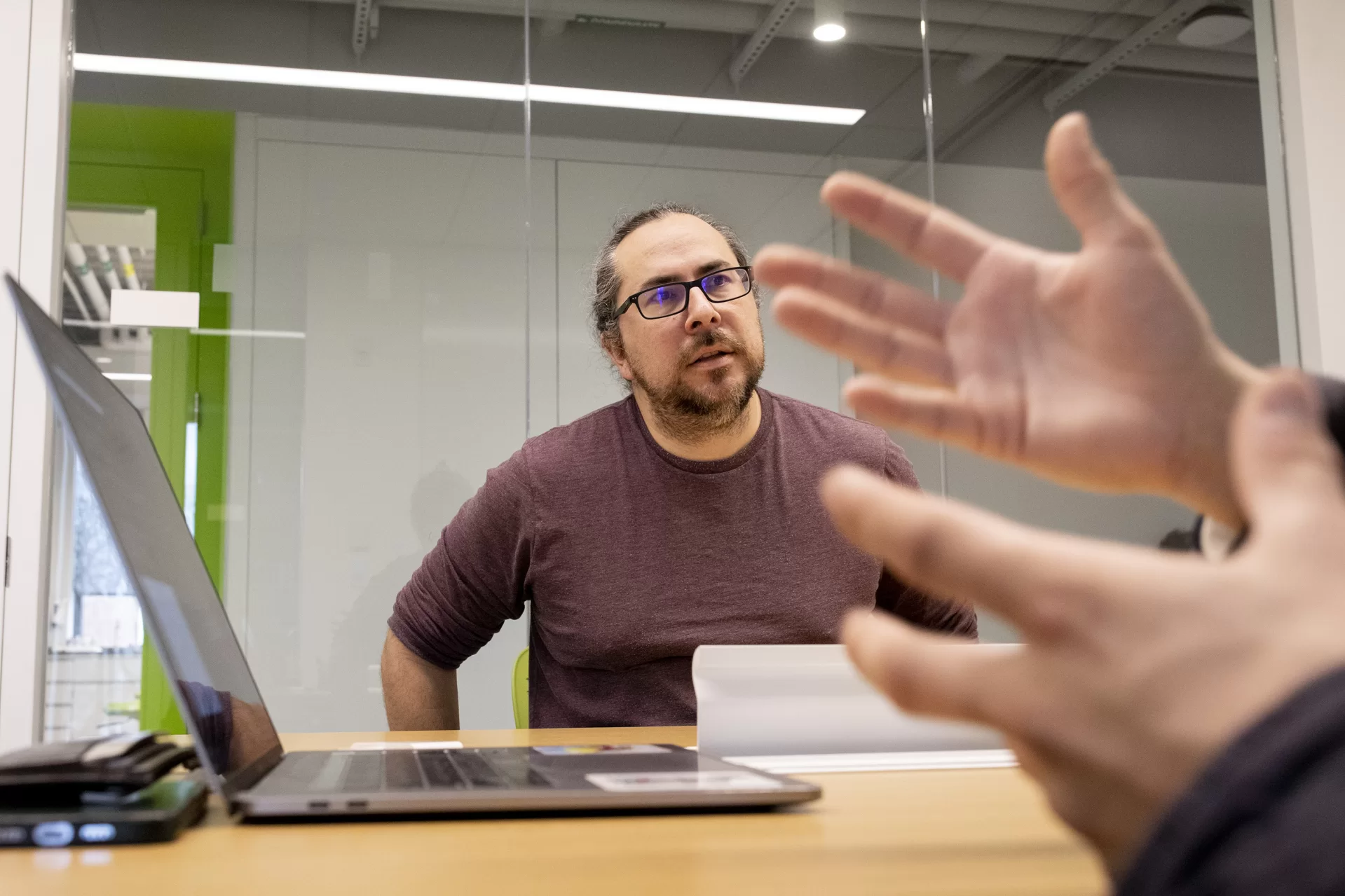
He and his students are testing the idea that there are different sub-divisions within the olfactory system — or “noses within the nose” that are each specialized for smelling different classes of chemicals.
Before moving to Bonney, Castro had two workplaces: His office in Hathorn Hall, and his lab in Carnegie Science Hall. “I was constantly running back and forth across campus. Now I’m spoiled — the lab is just a few paces away from my office.”

